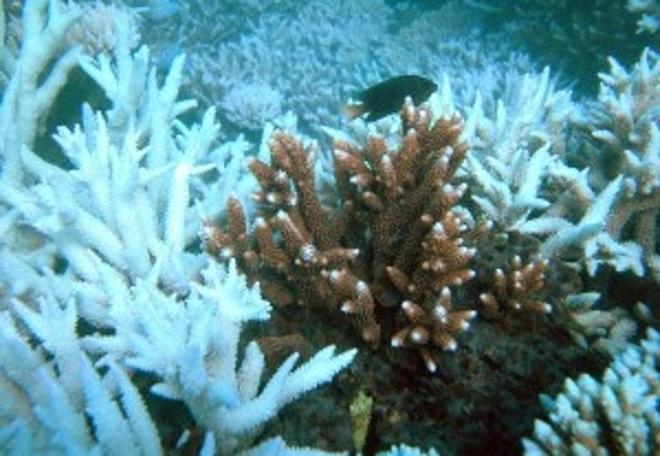Research uncovers how some coral can survive annual bleaching events
by coralcoe.org.au on 23 Nov 2015

Fish swim amongst bleached coral coralcoe.org.au
A study has found that coral with high levels of fat or other energy reserves can withstand the impact of annual coral bleaching events, compared to coral with lower levels of fat reserves.
Coral bleaching events occur when sea temperatures rise as the result of climate change. This results in the breakdown of the symbiosis between the coral and their zooxanthellae (which gives coral most of its colour) and threatens the survival of the coral.
The study was carried out by scientists from The University of Western Australia’s Oceans Institute and the ARC Centre of Excellence for Coral Reef Studies, The Ohio State University’s School of Earth Sciences and the University of Delaware’s School of Marine Science and Policy.
Lead author, Dr Verena Schoepf from the ARC Centre of Excellence for Coral Reef Studies at UWA and a Research Associate from the Oceans Institute, says tropical coral is extremely sensitive to heat stress.
“Three global bleaching events have already occurred since the 1980s and will likely occur annually later this century. Therefore, it has become more urgent than ever to know how tropical coral can survive annual bleaching – one of the major threats to coral reefs today,” she said.
“Already bleaching events have resulted in significant amounts of coral dying causing impact to ocean ecosystems, but up until now it was largely unknown whether coral could recover between annual bleaching events.”
Dr Schoepf says the research which simulated annual coral bleaching found some species of coral such as the mustard hill coral (Porites astreoides) were severely affected by repetitive bleaching events, but other coral such as the finger coral (Porites divaricata) and the mountainous star coral (Orbicella faveolata) could recover quickly.
“When coral is bleached, it no longer gets enough food energy and so it starts slowing down in growth and loses its fat and other energy reserves – just like humans do during times of hardship,” she says.
“The coral then becomes increasingly weak and susceptible to disease, and when bleaching is prolonged, it can die.”
Dr Andrea Grottoli from The Ohio State University’s School of Earth Sciences says over the next decades, coral bleaching events were likely to occur more and more frequently and increasingly impact coral reefs around the world, contributing to their worldwide decline.
“Bleaching will significantly change the future of coral reefs with heat sensitive coral unable to recover,” Dr Grottoli says.
“Our research will help with predicting the persistence of coral reefs because knowledge of their capacity to recover from annual bleaching is critical information for these models.”
The research, which was funded by the USA National Science Foundation to Drs. Grottoli and Warner, will be published in the international journal Proceedings of the Royal Society B: Biological Sciences
here
If you want to link to this article then please use this URL: www.sailworldcruising.com/140470